It’s very important to clean kitchen cloths well after they touch raw meat. Just wiping or rinsing them isn’t enough. Knowing how to disinfect kitchen cloths after wiping raw meat is essential to eliminate harmful bacteria effectively. This guide will show you how to clean and sanitize these cloths properly. This way, you can make sure your kitchen is safe to cook in.
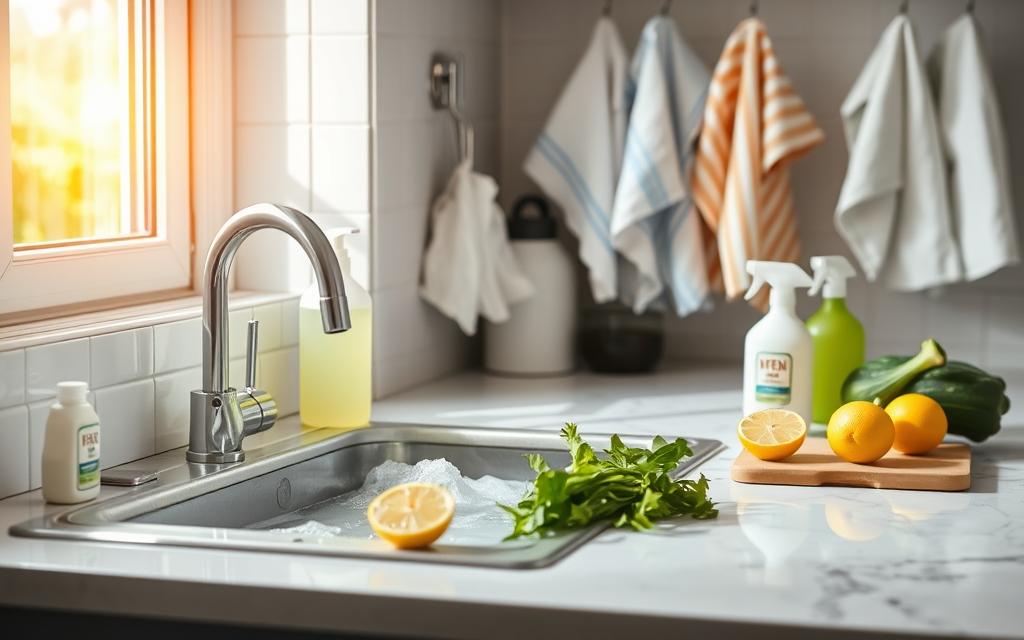
Key Takeaways
- Washing or rinsing meat or poultry increases the risk of cross-contamination in the kitchen, leading to foodborne illnesses.
- A bleach solution of one tablespoon of bleach per gallon of water can be used to disinfect kitchen cloths after handling raw meat.
- Proper handwashing for at least 20 seconds is crucial before and after handling raw meat to remove bacteria.
- Cooking meat and poultry to the correct internal temperature is vital for killing harmful bacteria.
- Storing raw meat securely in the refrigerator on the bottom shelf helps prevent contamination of other foods.
Why Disinfection is Essential for Kitchen Cloths
Keeping your kitchen clean is key to avoiding foodborne illnesses. Bacteria like Campylobacter and Salmonella can live on surfaces for a long time. They can spread to other foods or surfaces, causing illness.
Understanding Cross-Contamination
Cross-contamination happens when harmful bacteria move from one place to another. This often occurs through dirty kitchen cloths. Using the same cloth to clean surfaces that have touched raw meat and then ready-to-eat foods can spread bacteria. Following meat handling guidelines and cleaning cloths well can stop this.
Health Risks Associated with Raw Meat
Raw meat, poultry, and eggs carry more bacteria than other foods. Eating them without cooking can make you sick. Symptoms include diarrhea, vomiting, and sometimes, you might need to go to the hospital.
Importance of Kitchen Hygiene
A clean kitchen is vital for food safety. This means washing and disinfecting kitchen cloths often. Doing this can lower the chance of getting sick from food. It makes cooking safer for everyone in your home.
“1 in 6 Americans will get sick from food poisoning this year, and 128,000 Americans are sent to the hospital each year due to food poisoning.”
Signs Your Cloths Need Disinfecting
Keeping your kitchen clean and safe is key, more so when dealing with raw meat. Kitchen cloths can harbor harmful bacteria if not cleaned right. Watch for these signs to keep your cloths clean:
Visible Stains and Odors
Stains and strong smells on cloths mean they’ve got food, grease, and bacteria. Wash and disinfect them fast to stop food sickness.
Frequent Use and Wear
Cloths used a lot, like after raw meat, get dirty faster. As they wear out, they can’t clean as well. Change them often to keep things clean.
Color Changes or Damage
Notice if your cloths change color or get damaged. Discoloration or damage means they can’t be cleaned well anymore. It’s time for new ones.
Check your kitchen cloths often and fix these issues. This way, you keep your kitchen clean and safe for food. Clean cloths help stop cleaning meat residue and keep your kitchen clean.
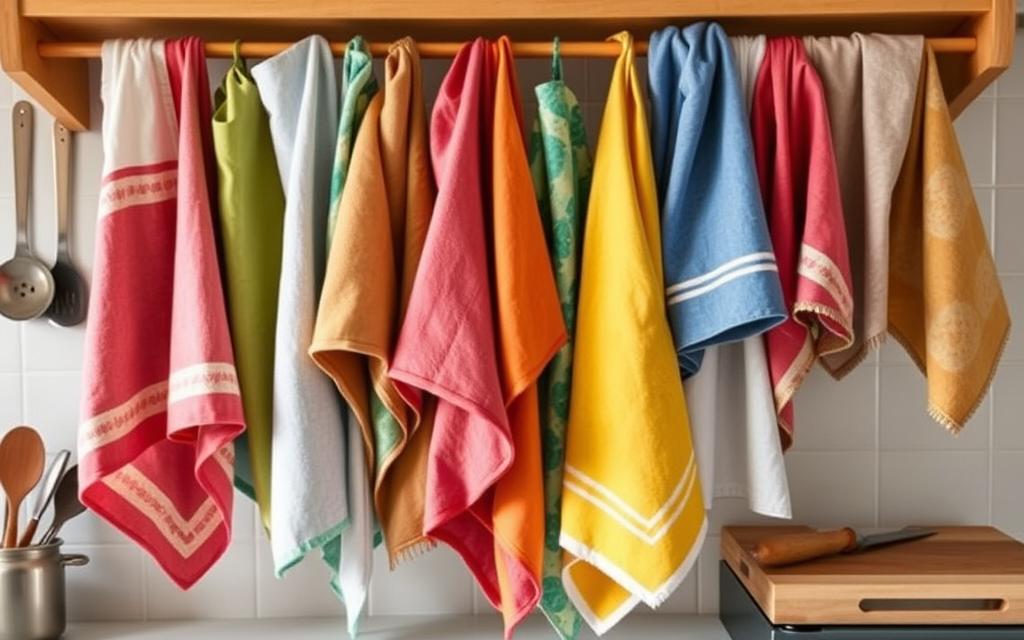
Best Practices for Cleaning Kitchen Cloths
Keeping your kitchen clean and safe starts with taking care of your kitchen cloths. It’s key to use different cloths for raw and cooked foods. This stops harmful bacteria from spreading.
Separating Cloths for Raw and Cooked Foods
Have one set of cloths for raw meat, poultry, or seafood. Use another set for surfaces that only have cooked or ready-to-eat foods. This simple step helps keep your kitchen clean.
Washing vs. Disinfecting: What’s the Difference?
Washing your cloths in warm, soapy water is a good start. But, it’s not enough to kill all bacteria. To kill any remaining germs, you need to disinfect. Use a food-safe disinfectant or a bleach solution to soak your cloths.
| Washing | Disinfecting |
|---|---|
| Physically removes dirt and some bacteria | Kills remaining harmful pathogens |
| Necessary for basic cleaning | Essential for complete disinfection |
| Leaves some bacteria behind | Effectively eliminates bacteria and viruses |
Good dishwashing and kitchen hygiene are vital for a safe cooking space. By following these tips, your kitchen cloths will be clean and disinfected. This reduces the chance of foodborne illnesses.
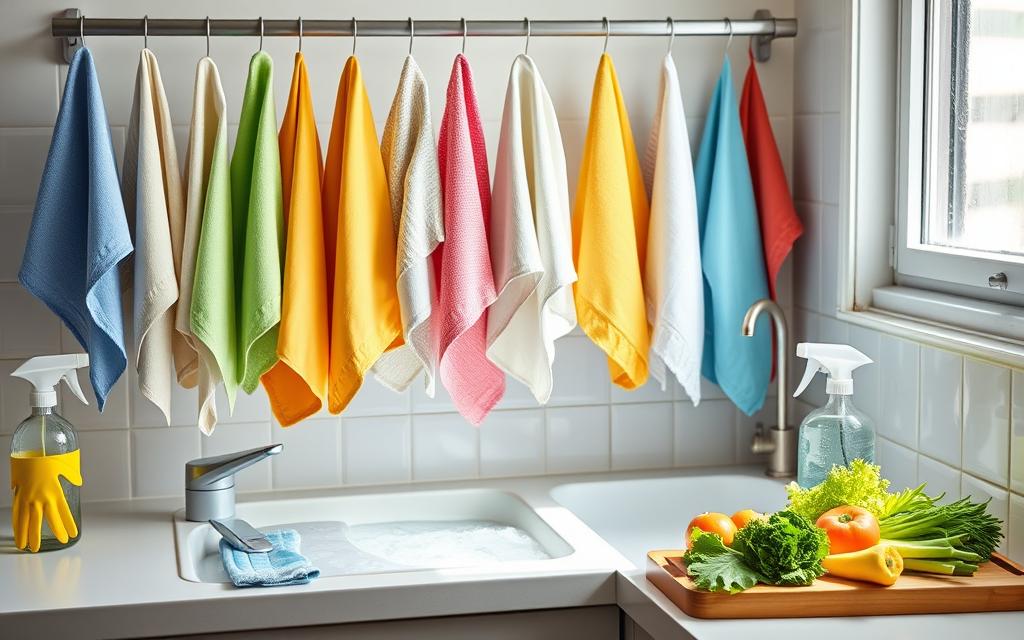
Cleaning Cloths with Soap and Water
Keeping your kitchen clean and safe is key. This is true, even more so when dealing with meat residue. Start by washing your kitchen cloths with warm, soapy water.
Choosing the Right Soap
Choose a dish soap that fights grease and dirt well. It should also have antibacterial properties. This helps get rid of meat residue and bacteria.
Effective Washing Techniques
- Fill a sink or large bowl with warm, soapy water using your chosen dish soap.
- Submerge the kitchen cloths and let them soak for a few minutes to help loosen any stuck-on food particles.
- Gently scrub the cloths, paying extra attention to areas that may have come into contact with raw meat.
- Rinse the cloths thoroughly under running water to remove all traces of soap and dirt.
- Wring out the cloths to remove excess water, ensuring they are not dripping wet.
First, clean your cloths well before disinfecting. This step removes physical dirt and prepares them for sanitizing. Washing with warm, soapy water is crucial for kitchen hygiene and stopping bacteria spread.
Cleaning is an essential first step to remove most germs from surfaces in your home, and using household cleaners with soap or detergent effectively eliminates germs and dirt, leaving surfaces clean.
Disinfecting with Bleach Solutions
Bleach is a strong antibacterial agent. It can clean your kitchen cloths after they touch raw meat. By making a simple bleach solution, you can soak your cloths. This kills harmful bacteria and keeps your kitchen safe.
Diluting Bleach for Safety
It’s important to dilute bleach correctly. Mix 1 tablespoon of liquid chlorine bleach with a gallon of water. This makes a solution that kills bacteria but is gentle on your cloths and skin.
Soaking Cloths in Bleach Solution
After mixing the bleach and water, soak your kitchen cloths for a few minutes. This lets the bleach’s antibacterial properties reach the fabric. Then, rinse the cloths well and let them dry before using them again.
Disinfecting your kitchen cloths with bleach regularly is key to a clean sanitized kitchen. This simple step helps prevent cross-contamination. It keeps your family safe from foodborne illnesses.
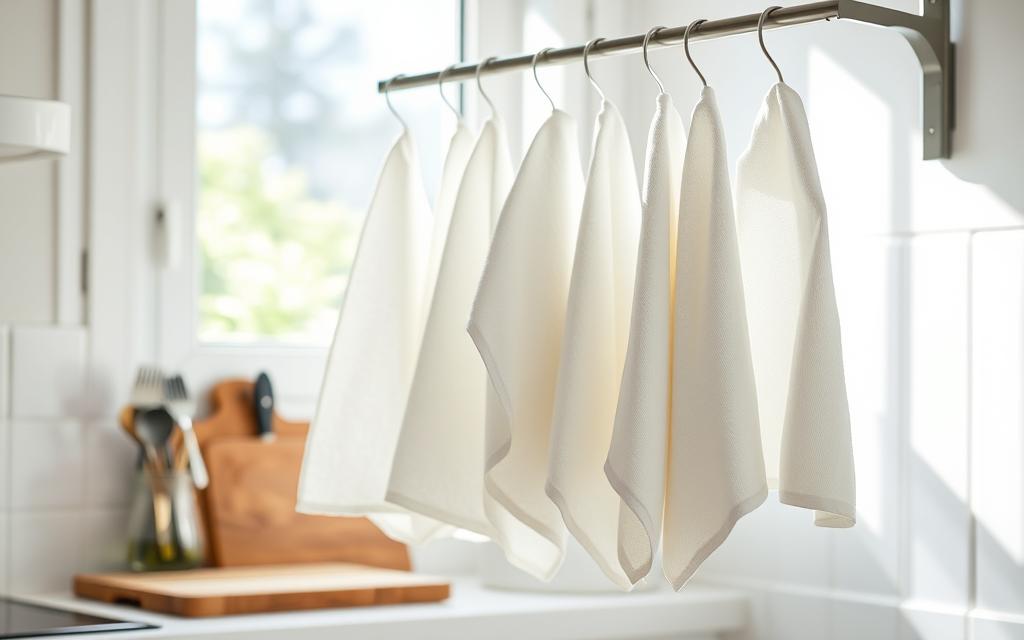
“Proper disinfection of kitchen cloths is crucial for preventing the spread of harmful bacteria like Salmonella and E. coli.”
Using Vinegar and Baking Soda as Alternatives
Using natural items like vinegar and baking soda is a smart choice for a clean kitchen. These ingredients are good at cleaning tough messes. They are also better for the environment and save money compared to antibacterial cleaning solutions.
Benefits of Vinegar for Disinfection
Vinegar, like white vinegar, is great at killing bacteria. It can get rid of E. coli, Salmonella, and Listeria. Mix it with water at a 50:50 ratio to clean kitchen surfaces, like countertops and cutting boards.
How to Combine Vinegar and Baking Soda
- Soak kitchen cloths in a mix of equal parts water and white vinegar.
- Rinse them and sprinkle with baking soda. This combo lifts stains and removes odors, making cloths fresh and clean.
- This two-step method is a safe and kitchen cleaning routine that avoids harsh chemicals.
Vinegar and baking soda might not work as well as bleach for very dirty cloths. But they are great for regular cleaning. Adding these to your kitchen cleaning routines helps keep your kitchen safe and healthy.
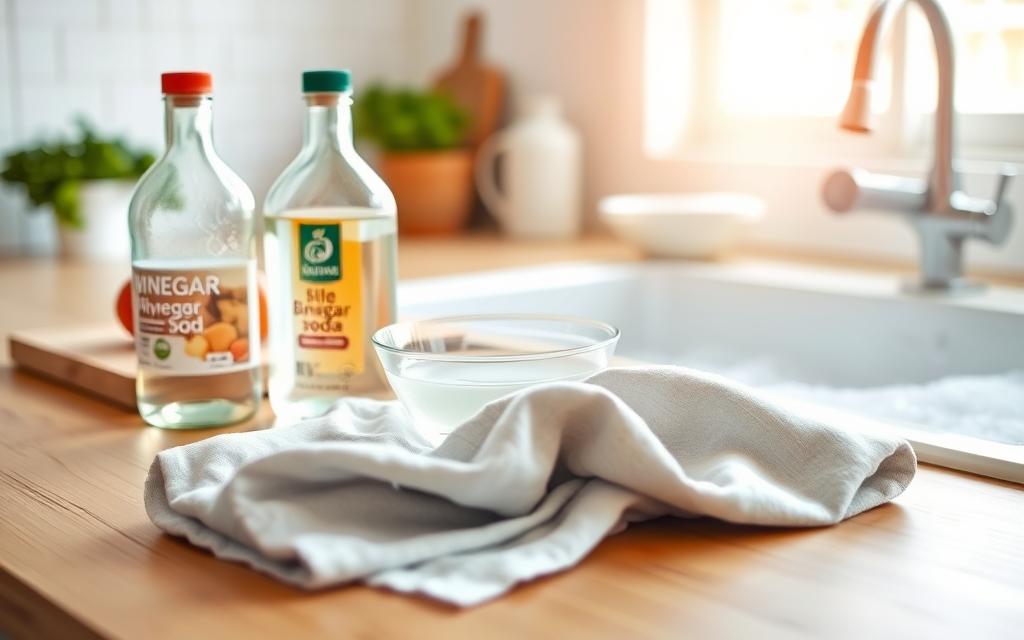
Washing Machine Disinfection Techniques
Keeping kitchen cloths clean and sanitized is key to stopping foodborne illnesses. Using your washing machine is a great way to disinfect them. By choosing the right wash settings and adding disinfectants, your cloths will be clean and ready for the next time.
Hot Water Wash Settings
Always use the hot water cycle when washing your kitchen cloths. Hot water is better at killing bacteria and removing grease and food particles. It also makes your detergent work harder, giving a deeper clean.
Adding Disinfectants to Your Wash
- Adding a disinfectant like bleach is a good idea. It kills many types of bacteria and viruses.
- For a gentler option, try white vinegar or hydrogen peroxide. They sanitize well without harming fabrics.
- Make sure to follow the instructions on the disinfectant product for the right amount to use.
Hot water and disinfectants together make sure your kitchen cloths are safe and ready for use. This keeps your kitchen clean and healthy.
“Proper dishwashing techniques and regular sanitization of kitchen cloths are essential for preventing the spread of foodborne illnesses in the home.”
Proper Drying Methods for Disinfected Cloths
It’s important to dry your kitchen cloths well after washing and disinfecting. This keeps your kitchen clean and stops germs from spreading. Using the right drying method helps get rid of any bacteria left behind.
Air Drying vs. Machine Drying
Air drying is the best way to dry your cloths. It’s safer because it avoids the risk of recontamination that machine drying can cause. If you must use a dryer, choose the highest heat to kill off any microbes.
Importance of Fully Drying Cloths
- Damp cloths can grow bacteria and mold, making your kitchen less clean.
- Dry cloths ensure the disinfectant worked, stopping cross-contamination.
- Moisture in cloths lets bacteria grow fast, which is bad for your kitchen.
| Drying Method | Advantages | Disadvantages |
|---|---|---|
| Air Drying |
|
|
| Machine Drying |
|
|
Choosing the right drying method is key. It makes sure your cloths are clean and ready for use. This keeps your kitchen safe and clean for cooking.
Regular Maintenance and Replacement Tips
Keeping your kitchen clean and safe is more than just cleaning cloths. It’s important to replace these tools often. This keeps your kitchen clean and safe for food. Over time, cloths can get worn, stained, and less effective, which can spread harmful bacteria.
When to Replace Kitchen Cloths
It’s best to change your kitchen cloths every few months. Do it sooner if they show signs of wear. Look for frayed edges, thin spots, or stains and smells that mean they’re not cleaning well.
Signs of Wear and Tear to Watch For
- Visible stains or discoloration that won’t come out, even after washing
- Frayed or worn edges that can’t be effectively cleaned
- Thinning fabric that compromises the cloth’s absorbency and cleaning power
- Persistent, lingering odors that suggest the growth of bacteria
Watching your kitchen cloths and replacing them often keeps your kitchen clean and safe. Fresh, high-quality kitchen cloths are key to a hygienic kitchen for food prep.
| Replacement Recommendations | Estimated Cost |
|---|---|
| 2 dozen huck towels | $20-$40 |
| 1 dozen cotton dishcloths | $10-$20 |
| 3-4 dozen cloth napkins | $30-$60 |
Buying new kitchen cloths often keeps your cleaning tools up to the task. This helps prevent foodborne illnesses and keeps your kitchen safe.
Storing Clean Cloths Safely
Keeping your kitchen clean is more than just washing cloths. It’s also about storing them right to avoid germs. After washing and disinfecting, find a clean spot to keep them. This spot should protect them from germs.
Designating a Clean Storage Area
Choose a dry, clean drawer or container for your cloths. Don’t keep wet cloths, as they can grow bacteria. Clean and disinfect this area often to keep it germ-free.
Hygiene Tips for Storing Cloths
- Keep kitchen cloths away from other household linens to stop germs from spreading.
- Make sure the storage area is clean and free from dirt and dust.
- Don’t stack or fold wet cloths, as this helps bacteria grow.
- Check the storage area often for mold, mildew, or other problems that could harm your cloths.
By having a clean storage spot and following good hygiene practices, you can keep your kitchen safe. This helps prevent foodborne illnesses by stopping germs from spreading.
| Best Practices for Storing Clean Kitchen Cloths | Explanation |
|---|---|
| Use a dedicated storage container | Choose a clean, dry spot just for your disinfected kitchen cloths to stop germs. |
| Avoid storing damp cloths | Wet cloths can grow bacteria, so keep them dry. |
| Regularly clean the storage area | Disinfect the area often to keep it clean for your cloths. |
| Store kitchen cloths separately | Keep them away from other household linens to prevent germs. |
Conclusion: Maintaining a Safe Kitchen Environment
To keep your kitchen safe, you must clean and disinfect regularly, mainly when dealing with raw meat. It’s important to disinfect kitchen cloths often and clean surfaces and utensils well. This helps stop foodborne illnesses. By doing these things, you can lower the chance of cross-contamination and make your cooking space clean.
Recap of Best Practices
Make sure to disinfect kitchen cloths often. You can wash them with soap and water, soak in a bleach solution, or use vinegar and baking soda. It’s also key to dry them well and keep them in a clean spot. Plus, wash your hands right, cook meat and poultry to the right temperature, and keep your kitchen tidy to stop foodborne pathogens.
Encouragement for Ongoing Kitchen Hygiene
Being proactive about kitchen hygiene is crucial for your family’s health. By making cleaning and sanitizing a regular part of your routine, you’ll have a clean and safe kitchen. Always remember, keeping food safe is the most important thing in the kitchen.
Leave a Reply